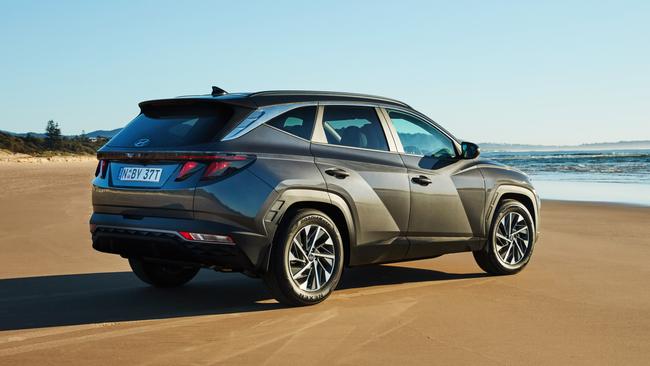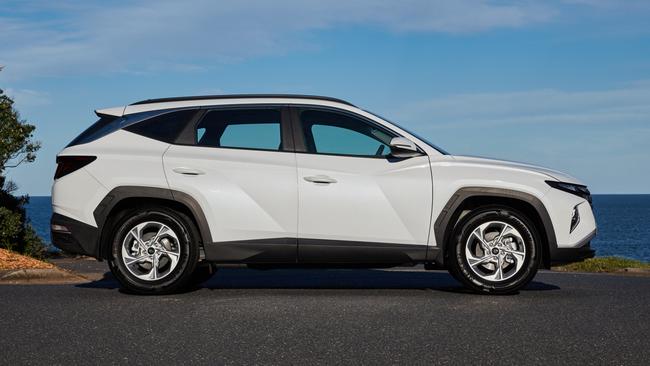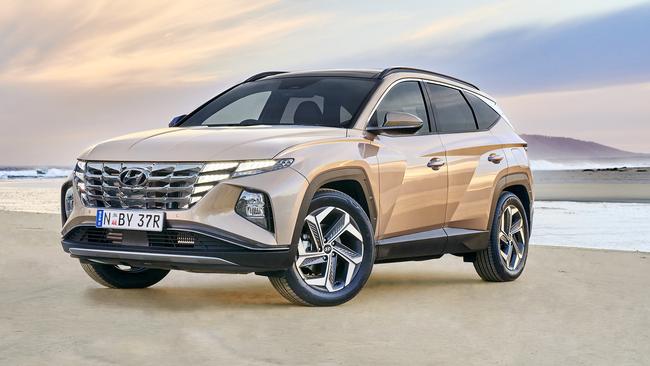2021 Hyundai Tucson review: Big price rise for popular SUV
The South Korean brand has launched a new version of its popular SUV, but those looking for a bargain will be disappointed.
New Cars
Don't miss out on the headlines from New Cars. Followed categories will be added to My News.
If you’re looking for a razor-sharp deal on a family-sized SUV, Hyundai’s Tucson no longer fits the bill.
While drive-away deals on the previous model sometimes dipped below $30,000, the new Tucson starts at a little more than $38,000 on the road.
Price rises have been a common theme in the car industry in recent years as brands abandon the slim margins and cutthroat competition at the bottom end of the market, preferring to offer more car for more money.

The new Tucson starts at $34,500 plus on-roads, $2360 more than the old model’s official asking price.
For that, you get a roomier cabin, more gadgets and a comprehensive suite of driver aids.
There’s also a noticeable step up in the presentation of the cabin.
Hard, scratchy plastics have been replaced by softer surfaces and interesting cloth highlights on the dash and doors.
The centre touchscreen looks more modern and the top of the range Highlander model has a digital display in front of the driver in place of the traditional dials and needles.

Hyundai has ditched the Active X model in favour of an N-Line option that includes bigger alloy wheels, sporty leather and suede seats, a digital driver display, LED front and rear lights and sportier exterior styling cues.
It costs $3500 extra on the Active model, $2000 on the mid-level Elite and $1000 on the Highlander.
Hyundai expects roughly half its customers to opt for the N-Line pack.
The company’s chief operating officer, John Kett, says the amount of extra equipment justifies the price rise.

“I think if you look at the content and how it’s specced relative to the key competitors, we feel comfortable with that,” he says.
That content includes an impressive arsenal of driver aids available on all models.
The Tucson can detect when you’ve missed a car in your blind spot and pull you back into your lane to avoid a collision.
It will also hit the brakes if you try to turn into oncoming traffic or reverse out of your driveway when it’s not safe.

Unlike most rivals, it can detect pedestrians behind you when you’re reversing and brake if necessary.
Finally, it won’t let you or your passengers open a door into passing traffic.
If a crash happens, a centre airbag stops driver and passenger from bumping heads.
Tech party tricks include wireless charging and wireless Apple CarPlay/Android Auto.
You can also mute the audio volume in the back seats if the kids nod off while you’re driving and there are four USB outlets for charging devices.
The Elite model, which starts from $39,000 plus on-roads, has a bigger centre screen, heated leather seats, climate control aircon and a wider choice of engines.

The Highlander, available for the first time in front-wheel-drive, starts at $46,000 and brings the digital driver display, a Bose sound system, sunroof, blind-spot camera, power tailgate and ambient lighting.
Rear leg and headroom are generous, the load area is long and wide and the full-size spare under the floor is a welcome inclusion for rural buyers.
While the Tucson’s cabin is a big step forward, the same can’t be said of the engine line-up.
Initially, it will only be available with a 2.0-litre four-cylinder that has less power and torque than its predecessor (down from 122kW/205Nm to 115kW/192Nm) despite having to shift roughly 60kg more weight.

Over the next couple of months, 1.6-litre turbo petrol and 2.0-litre diesel engines will become available on all-wheel-drive versions of the Elite and Highlander.
The 132kW turbo petrol version is matched to a seven-speed dual-clutch auto and costs $4000 more, while the 137kW diesel has an eight-speed dual-clutch auto and costs $6000 more.
It’s a shame the better engines aren’t available on cheaper front-drive models, because performance from the standard 2.0-litre engine is only just adequate.
It needs to be revved hard and noisily up hills and the six-speed auto tends to hunt busily for the best gear, making for less than serene progress.
To rub salt into the wounds, it’s slightly less efficient than the previous engine.
The Tucson soaks up bumps and road ripples well at low speeds and remains composed through the corners, although the steering lacks the feedback of some rivals.
VERDICT 3.5/5
Bargain hunters may be disappointed but the new Tucson represents solid value for money.
2021 HYUNDAI TUCSON VITALS
Price: From about $38,000 drive-away
Engine: 2.0-litre 4-cyl petrol, 115kW/192Nm
Warranty/servicing: Five years, unl’td km, $1595 over five years
Safety: Seven airbags, auto emergency braking, blind-spot and lane-keep assist, radar cruise, rear cross-traffic alert
Thirst: 8.1L/100km
Cargo: 539L
Originally published as 2021 Hyundai Tucson review: Big price rise for popular SUV





